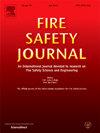Structural behavior of timber columns in wood crib compartment fire tests
IF 3.3
3区 工程技术
Q2 ENGINEERING, CIVIL
引用次数: 0
Abstract
Timber framing is increasingly used as a load-bearing structural system in mid-rise and high-rise buildings. While extensive data exists from standard furnace tests, there is a lack of data on the fire performance of loaded timber members in full-scale compartment fires. Compartment fire tests are crucial to investigate a structure's performance under conditions where the fire is let to grow naturally with the fuel and oxygen present in the room and then let to cool down as the fuel burns out. This paper presents the findings from six fire tests performed on glue laminated timber columns in a custom-built compartment. Wood cribs are used as fuel. The columns, 3680 mm long with a 280 × 280 mm2 section, are subjected to constant axial loading during the whole fire duration. Column design and loading are based on a 60-min fire resistance. The tests vary in opening factor, fire load, and wood crib size. Column failure was observed in the six tests, with failure times ranging from 35 to 71 min. In four of the tests, failure occurred after the gas temperature had started to cool down. Comparisons with tests on similar columns made in a fire resistance furnace allow comparing charring rates observed in standard conditions and in natural fires.
木槽室防火试验中木柱的结构性能
木结构作为一种承重结构体系在中高层建筑中的应用越来越广泛。虽然从标准炉膛试验中获得了大量数据,但在全尺寸隔间火灾中,缺乏关于加载木材构件防火性能的数据。在这样的条件下,舱室着火测试对于研究结构的性能至关重要,在这种情况下,火焰与房间内的燃料和氧气一起自然生长,然后随着燃料燃烧殆尽而冷却。本文介绍了在定制隔间中对胶合木柱进行的六次防火测试的结果。木床被用作燃料。柱长3680毫米,截面为280 × 280平方毫米,在整个火灾期间承受恒定的轴向载荷。柱的设计和加载是基于60分钟的耐火。测试在开口系数、火灾负荷和木床尺寸上有所不同。在六次试验中观察到柱的破坏,破坏时间从35到71分钟不等。在四次试验中,破坏发生在气体温度开始冷却之后。与在耐火炉中进行的类似柱的测试进行比较,可以比较在标准条件下和在自然火灾中观察到的炭化率。
本文章由计算机程序翻译,如有差异,请以英文原文为准。
求助全文
约1分钟内获得全文
求助全文
来源期刊

Fire Safety Journal
工程技术-材料科学:综合
CiteScore
5.70
自引率
9.70%
发文量
153
审稿时长
60 days
期刊介绍:
Fire Safety Journal is the leading publication dealing with all aspects of fire safety engineering. Its scope is purposefully wide, as it is deemed important to encourage papers from all sources within this multidisciplinary subject, thus providing a forum for its further development as a distinct engineering discipline. This is an essential step towards gaining a status equal to that enjoyed by the other engineering disciplines.
 求助内容:
求助内容: 应助结果提醒方式:
应助结果提醒方式:


